This article was co-authored by Neal Blitz, DPM, FACFAS. Dr. Neal Blitz is a Podiatrist and Foot & Ankle Surgeon who runs private practices in New York City and in Beverly Hills, California. Dr. Blitz is “The Bunion King®” and is the creator of the Bunionplasty® Procedure (plastic surgery for bunions) which has revolutionized bunion surgery. He has over 17 years of podiatric experience and specializes in minimally invasive foot and ankle surgery. Dr. Blitz received his DPM from the New York College of Podiatric Medicine, then completed a residency focused on Elective & Reconstructive Foot & Ankle Surgery at the Swedish Medical Center, and was awarded an AO Trauma fellowship in Dresden, Germany, focused on trauma and reconstructive techniques. He is board certified in Foot Surgery and Reconstructive Rearfoot & Ankle Surgery and is also a Diplomate of the American Board of Foot & Ankle Surgery and a fellow of the American College of Foot & Ankle Surgeons (FACFAS).
This article has been viewed 385,442 times.
Your foot contains about 26 bones, and many of these bones are prone to injury. You can break a toe if you kick something, you can break your heel if you jump from a certain height and land on your feet, and you can also break other bones when you twist or sprain your foot. Though children tend to break bones more often than adults, their feet are often more flexible than adult feet and they tend to bounce back more quickly from a broken foot.
Steps
Recognizing the Symptoms of a Broken Foot
-
1Note if it is too painful to walk on your foot. The major symptom of a broken foot is overwhelming pain when you try to put any pressure at all on your foot or walk on your foot.[1]
- If you have a broken toe, you can usually still walk and not be in too much pain. A broken foot will be overwhelmingly painful to walk on. Boots will often mask the pain of a break by providing a degree of support; removing them after a suspected fracture is the best way to diagnose the injury.
-
2Try to take your socks and shoes off. This will help you determine if your foot is broken, as you can compare your two feet side by side.[2]
- If you cannot get your shoes and socks off, even with the assistance of someone else, you should go to the nearest emergency room or call 911. Your foot is likely broken and requires immediate medical care. Cut the boot and sock off before swelling damages the foot.
- Typically if you break your foot, there's some type of trauma that goes along with that. For instance, you might have smashed it or stubbed your toe. However, a stress fracture is caused by a repetitive action like playing sports or even walking.[3]
Advertisement -
3Compare your feet and look for signs of bruising, swelling, and injury. Check if your injured foot is swollen, as well as the toes on that foot. You can also compare your injured foot with your healthy foot to see if it appears very red and inflamed, or has deep purple and green bruising all over it. You may also notice open wounds on your injured foot.[4]
- If you have a significant break, broken blood vessels will cause bruising around the area.[5]
- Swelling is normal for most injuries. However, if you have a severe fracture, the swelling might be so bad that it leads to blisters on your skin, because the fluid doesn't have anywhere to go.[6]
-
4Check if the foot is broken or just sprained. You can also try to determine if the foot is sprained or broken. Sprains occur when you stretch or tear a ligament, which is the tissue that connects two bones together. Breaks are a fracture or complete break of the bone.[7]
- If you see any bones sticking out through the skin, you have an open fracture. Seek emergency medical care, as this can quickly lead to an injury.[8]
-
5Head to the nearest emergency room. If your injured foot appears to be broken, you should head to the nearest emergency room. If you are alone and no one can assist you, call 911. Do not drive yourself to the emergency room if you have a broken foot.[9] Any broken bone can cause shock, which makes it too dangerous for you to drive yourself.
- If someone is able to drive you to the emergency room, you should try to stabilize your foot so it is secure while you are in the car and does not move around. Use a pillow and slide it under your foot. Secure it with tape or tie it to your foot so it helps your foot to stay upright. Try to keep your foot elevated as you travel; sit in the back seat to elevate your foot if you can.
Getting the Foot Treated by a Doctor
-
1Let the doctor examine your foot. The doctor will press on several areas of your foot to determine if your foot is broken. You may feel some pain as she does this, which is an indicator that the foot is broken.[10]
- If your foot is broken, you may feel pain when the doctor presses on the base of your baby toe and at the mid-foot. You may also be unable to take four or less steps without assistance or without significant pain.
-
2Allow the doctor to X-ray your foot. If the doctor suspects you have broken bones in your foot, she will do an X-ray on your foot.
- However, even with an X-ray it can be difficult to determine if your foot is broken as swelling can obscure the fine bones in the foot. Using an X-ray, the doctor may be able to identify which bones in your foot are broken and how they can be treated.
-
3Ask the doctor about your treatment options. The treatment options for your broken foot will depend on what bones you have broken in your foot.
- If you have broken your heel or fractured your heel, you may require surgery. As well, if you have broken your talus, which is the bone that attaches your foot to your leg, you may require surgery. But if you fractured your little toe or other toes, you likely do not require surgery.
Caring for the Foot at Home
-
1Stay off your foot as much as possible. Once your broken foot is treated by a doctor, you should focus on staying off your foot as much as you can. Use crutches to get around and make sure you put your full weight on your arms, hands, shoulders, and the crutches, not on your foot.
- If you have a broken toe or toes, your broken toe may be taped to its neighboring toe to keep it from moving. You should put no weight on your broken toe and give it six to eight weeks to heal fully.
-
2Elevate your foot and apply ice to reduce swelling. Put your foot on a cushion in bed or on a high chair when sitting so it is higher than the rest of your body. This will help to keep the swelling down.
- Icing your foot can also reduce swelling, especially if it is in bandages, not a cast. Apply the ice for 10 minutes at a time, reapplying every hour for the first 10 – 12 hours of the injury.
-
3Take pain relievers, as prescribed by your doctor. Your doctor should give you pain relievers or recommend over-the-counter pain relievers you can use to help manage the pain. Only take them as prescribed by your doctor or as specified on the label.
-
4Schedule a follow up exam with your doctor. Most foot fractures take six to eight weeks to heal. You should schedule a follow-up exam with your doctor once you are able to start walking and putting weight on your foot. Your doctor may recommend you use a rigid and flat-bottomed shoe to help your foot heal properly.
Expert Q&A
Did you know you can get expert answers for this article?
Unlock expert answers by supporting wikiHow
-
QuestionWhat symptoms might indicate a broken foot?
 Neal Blitz, DPM, FACFASDr. Neal Blitz is a Podiatrist and Foot & Ankle Surgeon who runs private practices in New York City and in Beverly Hills, California. Dr. Blitz is “The Bunion King®” and is the creator of the Bunionplasty® Procedure (plastic surgery for bunions) which has revolutionized bunion surgery. He has over 17 years of podiatric experience and specializes in minimally invasive foot and ankle surgery. Dr. Blitz received his DPM from the New York College of Podiatric Medicine, then completed a residency focused on Elective & Reconstructive Foot & Ankle Surgery at the Swedish Medical Center, and was awarded an AO Trauma fellowship in Dresden, Germany, focused on trauma and reconstructive techniques. He is board certified in Foot Surgery and Reconstructive Rearfoot & Ankle Surgery and is also a Diplomate of the American Board of Foot & Ankle Surgery and a fellow of the American College of Foot & Ankle Surgeons (FACFAS).
Neal Blitz, DPM, FACFASDr. Neal Blitz is a Podiatrist and Foot & Ankle Surgeon who runs private practices in New York City and in Beverly Hills, California. Dr. Blitz is “The Bunion King®” and is the creator of the Bunionplasty® Procedure (plastic surgery for bunions) which has revolutionized bunion surgery. He has over 17 years of podiatric experience and specializes in minimally invasive foot and ankle surgery. Dr. Blitz received his DPM from the New York College of Podiatric Medicine, then completed a residency focused on Elective & Reconstructive Foot & Ankle Surgery at the Swedish Medical Center, and was awarded an AO Trauma fellowship in Dresden, Germany, focused on trauma and reconstructive techniques. He is board certified in Foot Surgery and Reconstructive Rearfoot & Ankle Surgery and is also a Diplomate of the American Board of Foot & Ankle Surgery and a fellow of the American College of Foot & Ankle Surgeons (FACFAS).
Board Certified Podiatrist That will depend on the severity of the fracture. For a stress fracture, you might have dull pain, swelling, and bruising. More severe breaks might lead to swelling that's significant enough that it causes blisters on your skin. Some breaks might even pierce through the skin, which is considered a medical emergency.
That will depend on the severity of the fracture. For a stress fracture, you might have dull pain, swelling, and bruising. More severe breaks might lead to swelling that's significant enough that it causes blisters on your skin. Some breaks might even pierce through the skin, which is considered a medical emergency.
References
- ↑ http://www.emedicinehealth.com/broken_foot/article_em.htm
- ↑ http://www.emedicinehealth.com/broken_foot/article_em.htm
- ↑ Neal Blitz, DPM, FACFAS. Board Certified Podiatrist. Expert Interview. 22 April 2020.
- ↑ http://www.emedicinehealth.com/broken_foot/article_em.htm
- ↑ Neal Blitz, DPM, FACFAS. Board Certified Podiatrist. Expert Interview. 22 April 2020.
- ↑ Neal Blitz, DPM, FACFAS. Board Certified Podiatrist. Expert Interview. 22 April 2020.
- ↑ https://www.urmc.rochester.edu/encyclopedia/content.aspx?ContentTypeID=1&ContentID=1889
- ↑ Neal Blitz, DPM, FACFAS. Board Certified Podiatrist. Expert Interview. 22 April 2020.
- ↑ http://www.emedicinehealth.com/broken_foot/article_em.htm
About This Article
The best way to tell if your foot is broken on your own is to assess the level of pain you're experiencing. If you feel immediate, throbbing pain deep in your foot or coming from the bone, your foot could be broken. If you only have pain coming from the softer tissue in your foot, not the bone, your foot might actually be sprained and not broken. If the pain gets worse when you move your foot, put pressure on it, or touch it, that's another red flag that it could be broken. You can typically walk on a sprained foot, but usually not on a broken foot. A broken foot may also look bruised and swollen, and sometimes it will look visibly deformed. If you're worried that your foot is broken, you should go to the emergency room for immediate care. For more tips from our Medical co-author, including how to ice your broken foot for pain and swelling relief, keep reading!
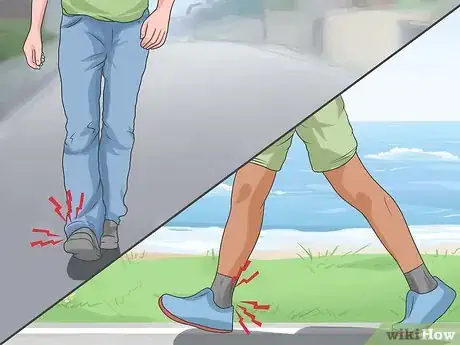
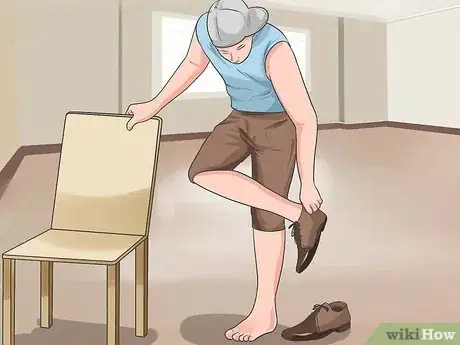

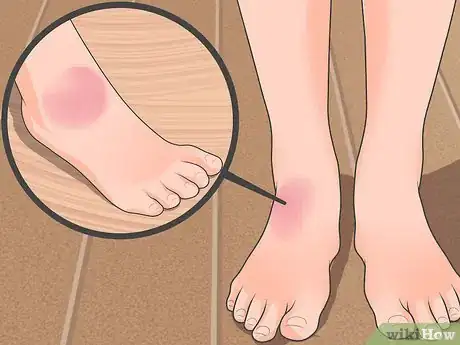
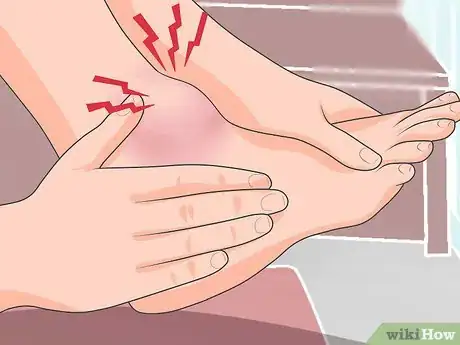

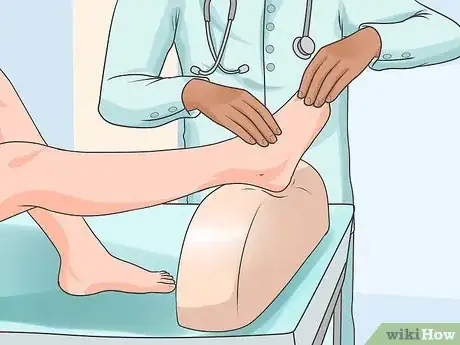
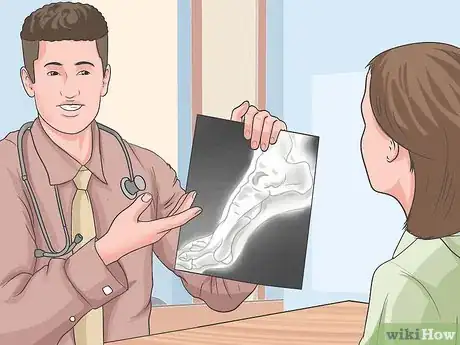

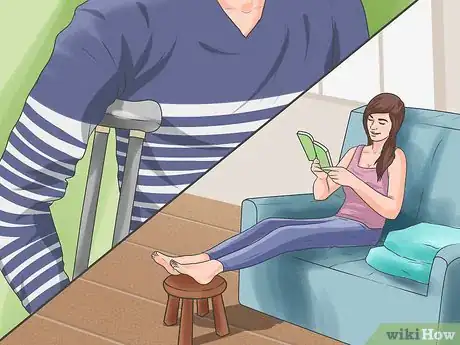
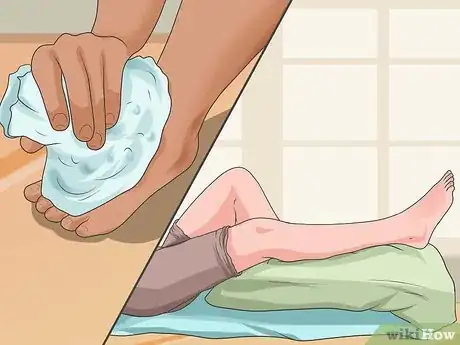






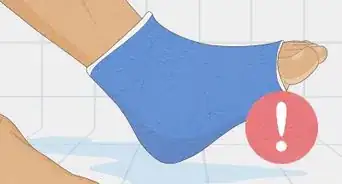
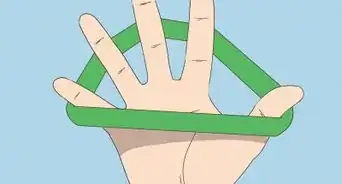
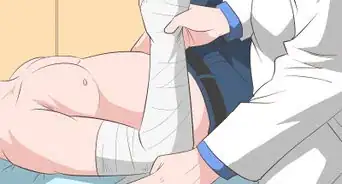
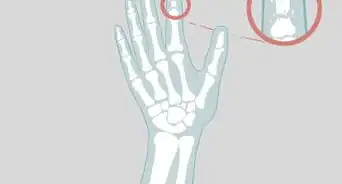


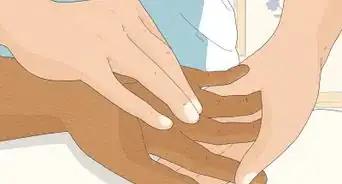
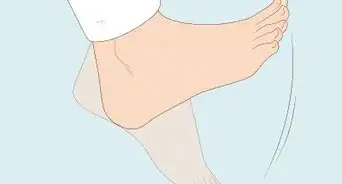











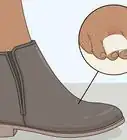






































Medical Disclaimer
The content of this article is not intended to be a substitute for professional medical advice, examination, diagnosis, or treatment. You should always contact your doctor or other qualified healthcare professional before starting, changing, or stopping any kind of health treatment.
Read More...